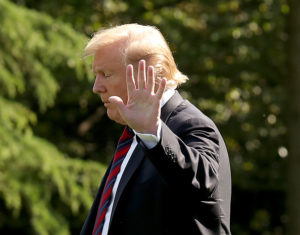Competitive. Temperamental. Petulant. Driven. All words that have been used to describe tennis great Andy Murray. However, in the world of 24 hour digital media and things that are “trending,” the new one is “feminist.”
In a sport where women rarely have equal financial footing as the men, Murray has become an outspoken advocate for the women’s game. We are not just talking about a player that gives lip service to the value of the women’s tennis. We are talking about a player who knows the sport’s history and the substantive relevance of the past to the present day.
After Murray lost to Sam Querry in the men’s quarterfinals of Wimbledon last week, a reporter said, “Andy, Sam is the first American player to reach the semi-final of a Slam since 2009…” Murray was quick to correct him. He interjected “male player.” The reporter was unsure of what was happening. “I beg your pardon?,” he responded. Murray repeated his correction. “Male player,” he reiterated.
Let that exchange soak in for a moment. This was not a male athlete who was being asked about the women’s game, and, having been well schooled by his management team, was giving a politically correct answer. This was one of the top four men’s players in the world, a Grand Slam champion, an Olympic gold medalist, who was aware at the drop of a hat that Serena and Venus Williams had each reached a grand slam semifinal in the last eight years. It is not a stretch to assume Murray would also know that so had American women Sloane Stephens, Coco Vandeweghe, and Madison Keys. He knew immediately what the reporter either forgot or perhaps did not even know–or that the reporter didn’t think that women counted as “players” in this conversation.
Murray instantly received worldwide appreciation for his knowledge and apparent support of the women’s game. Social media outlets had fans buzzing about Murray’s correction for the reporter, none the least of which was Judy Murray, Andy’s mother and former coach.
That's my boy. ❤️ https://t.co/ldZUQ2wbZj
— judy murray (@JudyMurray) July 12, 2017
https://twitter.com/svenja_mastro/status/885160905927000065
Perhaps the most vocal gratitude came from the top women’s player in the world. Serena Williams told ESPN: “I don’t think there’s a woman player – and there really shouldn’t be a female athlete – that is not totally supportive of Andy Murray. He has spoken up for women’s issues and women’s rights, especially in tennis, forever and he does it again. That’s one thing that we love about him. He has such a wonderful mother who’s been such a strong figure in his life and he’s done so much for us on our tour, so we love Andy Murray.
The US Open was the first of the tennis Grand Slams to award equal prize money for men and women players in 1973. Thirty-four years later, Wimbledon stepped up as the last of the four Grand Slams to make that same financial arrangement. The Women’s Tennis Association, (WTA), and the men’s tour, (Association of Tennis Professionals or ATP), often go in different directions for much of the year, and the prize money is rarely the same even when they do play the same best of three format.
While Murray may not be able to solve the prize money issues, he has been quick to advocate for the women’s game in the biggest of venues and events. As the reigning Wimbledon champion going into the 2017 tournament, he was outspoken about women getting more matches on Centre Court or Court 1. According to Fivethirtyeight.com, only 38% of matches on Centre Court were women’s matches in the 2015 Wimbledon tournament. Murray has said the women should have just as many matches on the prime courts as the men.
In 2016, the CEO of the BNP Paribas Indian Wells tournament, Raymond Moore, implied that women’s tennis owed all of its success to the men’s game. “You know, in my next life, when I come back, I want to be someone in the WTA because they ride on the coattails of the men. They don’t make any decisions, and they are lucky. They are very, very lucky. If I was a lady player, I’d go down every night on my knees and thank God that Roger Federer and Rafa Nadal were born because they have carried this sport. They really have.” To what should have been the surprise of no one, Murray was one of the first players to defend the women’s game. At a press conference after Moore resigned his post, Murray said, “Men’s tennis has been lucky over the last nine or 10 years with the players they’ve had, the rivalries which have come out of that. That’s great but the whole of tennis should capitalize on that – not just the men’s game. “
Murray comes by his advocacy naturally. His mother played professionally for a very brief time in the 1970s and coached Andy and his older brother Jamie through their junior tennis careers.
He was also only the second player ever on the ATP tour to hire a woman coach, when in 2014, he took on former French tennis standout Amelie Mauresmo. The partnership only lasted two years, which is not uncommon in the sport, but Murray told Sports Illustrated in 2016 that he gives Mauresmo credit for changes in him on and off the court. “When I first came on the Tour, I didn’t really think much about it. But I realized it when I started to work with Amelie. The comments and things I heard, and what people said to me, and the questions I was having to answer made me sort of realize there was something to this: She’s getting treated significantly differently to those working with a guy who’s been No. 1 in the world and has won multiple Slams. That’s when I started to realize there was still an issue.
Last year, at the Olympics in Rio, Murray was told by a BBC reporter that he was first tennis player to win two Olympic gold medals. Murray responded by acknowledging similar achievements, “I think Venus and Serena won about four each.” The Williams sisters have each won a singles championship and teamed up for three doubles gold medals. Leave it Murray to instinctively know his women’s tennis stats better than most.






